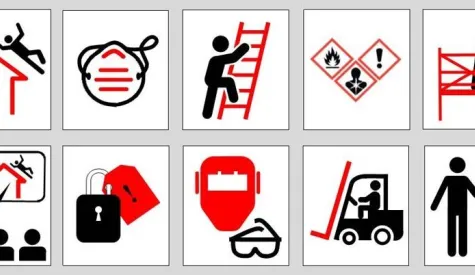How to Avoid Safety Recordkeeping Errors and Citations

Failure to maintain current and error-free workplace records can end up costing you loads of money in OSHA violations. Employers especially vulnerable to recordkeeping violations are those with multiple establishments or job sites because these situations present special compliance challenges and more exposure to violations.
In recent years, OSHA has more frequently handed out willful and repeat citations. OSHA also gives out more incident-by-incident citations, rather than grouping incidents and giving one citation for all of them.
When OSHA issues incident-by-incident penalties it can get very expensive very fast. Incident-by-incident citations were first employed in recordkeeping cases, and it’s very easy to make a mistake on your records log and end up having to pay egregious violation fines for it.
Recordkeeping Problem Areas
There are several recordkeeping issues that seem to be trouble spots for many employers. Common issues are:
- Improperly completed OSHA 300 Forms and related material
- Unnecessarily recorded incidents
- No coordination between workers’ compensation recordkeeping and OSHA recordkeeping, which should be kept in coordination
- Employers failing to perform audits or make corrections to documents
Performing Recordkeeping Audits
The first step when auditing your records is to determine everyone in your organization who maintains injury and illness records. You should also determine everyone's business reasons for maintaining records. To the extent possible, try to consolidate injury and illness recordkeeping into one system.
Perform self-audits of your records and logs every five years, making corrections along the way when you find errors. And remember that more than half of the U.S. states and territories are covered by an OSHA-approved State Plan, so you may need to check those rules as well to maintain full compliance.
Recordkeeping Exemptions
There are some exceptions to whether you must adhere to certain OSHA regulations. Here’s some information on several different exemptions and how they affect recordkeeping.
SUBPART B – Scope1904.1 Size Exemption
If your company had 10 or fewer employees during the last calendar year, you do not need to maintain injury and illness records unless requested by OSHA or the Bureau of Labor Statistics (BLS). Size exemption is based on the number of employees in the entire company, not just one location, and includes temporary employees.
Please note, certain low-risk industries are exempted.
1904.1 Partial Exemption
Employers that are partially exempt from recordkeeping requirements because of their size or industry must continue to comply with:
- 1904.39: Reporting fatalities, multiple hospitalization incidents, and amputation or loss of an eye
- 1904.41: Annual OSHA injury and illness survey (if specifically requested to do so by OSHA)
- 1904.42: BLS Annual Survey (if specifically requested to do so by BLS)
SUBPART C – Forms and Recording Criteria
1904.4 Recording Criteria
In most cases, to stay compliant with recording criteria, the employer supervising the injured employee must record the incident. Individual contractors do not have to be recorded. However, a common mistake inspectors find when examining records is that many individual independent contractors are misclassified and should be classified as employees.
Covered employers must record each injury, illness, or fatality that is work-related, is a new case, and meets one or more of the criteria contained in sections 1904.7 through 1904.11.
SUBPART D – Other Requirements
1904.30 Multiple Establishments
Employers must keep a separate OSHA 300 Log for each establishment that is expected to be in operation for more than a year. They may keep one OSHA 300 Log for all short-term establishments. Each employee must be linked to only one establishment, even if they have worked in more than one facility. Employers will determine which location serves as each employee’s primary facility.
1904.31 Covered Employees
Covered employees include employees on payroll and those who are not on payroll but are supervised daily. This excludes self-employed individuals and partners.
1904.32 Annual Summary
When performing an annual summary, employers should review their OSHA 300 Log for completeness and accuracy and correct any deficiencies they may discover. They will also need to complete the OSHA 300A Summary. Upon completion, the summary needs to be certified by a company executive, meaning an owner of the company, an officer of the corporation, or the highest-ranking company official working at the establishment.
Employers must post the OSHA 300A for a three-month period, from February 1 to April 30. It is not necessary to post the OSHA 300 Log.
For detailed information about OSHA 300 logs and forms 300A and 301, read this article: Making Sense of the OSHA 300 Log and OSHA Forms 300A and 301
1904.33 Retention and Updating
Employers are required to retain all OSHA forms for five years.
1904.35 Employee Involvement
There needs to be a way for employees to report work-related injuries and illnesses promptly. Employers must train each employee on how to report an injury or illness. It’s beneficial to include reporting procedures in your company policy book.
Limited access to injury and illness records needs to be made available to employees, former employees, and their personal and authorized representatives. These requirements are as follows:
- If requested, a copy of the OSHA 300 Log must be provided to an employee, former employee, personal representative, or authorized employee representative by the end of the next business day.
- If requested, a copy of the OSHA Form 301 must be provided to an employee, former employee, or personal representative by the end of the next business day.
- If requested, a copy of the OSHA Form 301 section titled “Tell us about the case” must be provided to an authorized employee representative within 7 calendar days.
SUBPART E- Reporting Information to the Government
1904.39 Fatality and Catastrophe Reporting
Within eight hours of any work-related fatality, employers must report the incident to the nearest OSHA Area Office, to the toll-free OSHA number, or via electronic submission.
Within 24 hours after an in-patient hospitalization, an amputation, or the loss of an eye, employers must report the incident to the nearest OSHA Area Office, to the toll-free OSHA number, or via electronic submission.
However, employers do not need to report highway or public street motor vehicle accidents that take place outside of a construction zone. They also do not need to report commercial airplane, train, subway, or bus accidents.
1904.40 Access for Government Representatives
When an authorized government representative asks for records under Part 1904, employers must provide copies within four business hours. It’s a good idea for employers to update their records log as they go, so they are always current and ready at a government representative’s request.
New OSHA Reporting Rules
On January 1, 2024, an expansion to OSHA’s injury and illness reporting rule took effect. Previously, there were two categories of workplaces that were required to submit annual injury and illness information to OSHA. Moving forward, there are now three workplace categories that must submit annual OSHA reports:
- An establishment that has 20–249 employees AND is classified in one of the high-hazard industries designated in Appendix A of OSHA’s Injury and Illness Recordkeeping and Reporting Requirements
- An establishment that has 250 or more employees AND is required to maintain injury and illness records
- An establishment that has 100 or more employees AND is classified in one of the high-hazard industries designated in the new Appendix B of OSHA’s Injury and Illness Recordkeeping and Reporting Requirements
- Note: this third category, along with Appendix B, was created under the rule change.
Visit HSI today to learn more about OSHA injury reporting and how an incident management can help you keep track of incidents and other issues, creating a huge time-saver when it comes time to submit your OSHA reports.


